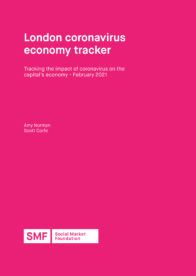This report, the fourth in a series commissioned by Peabody, updates our analysis of the impact of COVID-19 on London's economy. It explores the latest timely data on economic outcomes to produce an as up-to-date picture as possible.
Key findings:
- The latest claimant count data show unemployment declining slightly in both London and the UK as a whole. Between December 2020 and January 2021 the claimant count fell by 0.8% in the capital, similar to the 0.7% fall seen in the rest of the UK. On this measure of unemployment, this amounts to about 4,000 fewer people out of work.
- However, the claimant count in London remains over 300,000 higher than a year ago. In percentage terms, the claimant count increased by 173% in London over the past year, compared with 101% in the rest of the UK.
- The claimant count declined more rapidly in Outer London than Inner London between December and January. With central London office workers unlikely to return in great numbers until the summer, a jobs recovery in Inner London could prove decidedly muted in the first half of 2021.
- There are now five London boroughs where the unemployment rate, on the claimant count measure, is greater than or equal to 10%. These boroughs are Haringey (11.1%), Newham (10.6%), Brent (10.5%), Barking & Dagenham (10.4%) and Waltham Forest (10.0%)
- While new job openings have recovered in London since the start of the year, they remain about a quarter lower than mid-March 2020, prior to the UK first going into lockdown. In contrast, job vacancies in the rest of the UK now stand at comparable levels to mid-March
- While in March London had roughly one job vacancy per jobless benefits claimant – lower than the 1.7 seen in the rest of the UK – as of November we estimate that there are about 3.4 claimants for every job vacancy. This is marginally higher than the 3.3 claimants per vacancy seen for the rest of the UK.
- A high proportion of current job vacancies in London are in high-skill sectors such as teaching (8.1%), IT (25.7%) and accounting & finance (9.9%) – those that have lost work in sectors such as retail and hospitality are unlikely, in general, to have the necessary skillsets and qualifications for these job roles.
- Our analysis shows that Londoners saw a bigger decline in life satisfaction during lockdown last year, than those in the rest of the UK. This was particularly true for lower income Londoners. Average life satisfaction for Londoners in the lowest income quartile fell by 17% between 2017/18 and May 2020. This compared with a 9% decline for those in lower income households across the UK as a whole.

Download The Report: PDF
Kindly sponsored by

